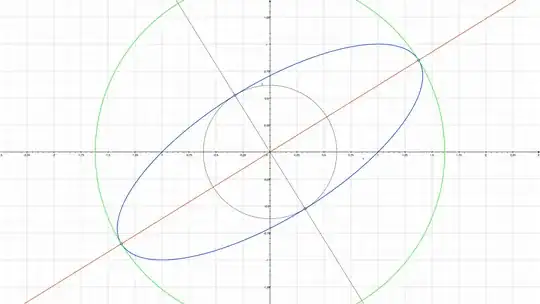What are the equations of the major and minor axes of the ellipse $x^2+2y^2-2xy-1=0$. The centre of the ellipse is $(0,0)$ but the axes are tilted (with respect to $x-y$ axes). I don't know how to find those.
-
Try completing the square. – Cardboard Box May 11 '14 at 16:22
-
http://en.wikipedia.org/wiki/Rotation_of_axes#Elimination_of_the_xy_term_by_the_rotation_formula – lab bhattacharjee May 11 '14 at 16:24
-
@math.n00b Are you saying something to me?? – idpd15 May 11 '14 at 18:01
-
I upvoted your answer by mistake...So i pressed the downvote button.. So I thought it cancelled out.. Didn't it? – idpd15 May 11 '14 at 18:03
-
Ah, I see. No, it doesn't cancel it out, it downvotes the answer and gives (-2) points to the writer, not that the reputation points matter, but I just felt frustrated because I thought you had downvoted it on purpose. If you want to reverse the upvote you have to click on the upvote button again to reverse it. – math.n00b May 11 '14 at 18:05
-
@math.n00b I am sorry buddy. I just pressed the downvote button thinking it would cancel out. Sorry again. By the way, yeah i did not understand ur answer(i am poor in linear algebra)-- but this wasn't the reason i downvoted ur answer!! – idpd15 May 11 '14 at 18:08
-
It's OK now. It was only a misunderstanding. Do you want me to edit my answer and explain in details how the method works? – math.n00b May 11 '14 at 18:10
-
@math.n00b Is there a way to know who downvoted/upvoted ur posts/answers? I used to believe there was no way – idpd15 May 11 '14 at 18:10
-
@math.n00b Definitely. please. This is the fun and beauty of maths. So many approaches to tackle a given question – idpd15 May 11 '14 at 18:11
-
1Yes. You can check reputational changes. If you suspect someone, you delete your answer, then the downvoter's reputation should increase by two points. Then you undelete your answer and the down-voter's reputation decreases by two points. – math.n00b May 11 '14 at 18:12
-
Clever! @math.n00b (y) – idpd15 May 11 '14 at 18:14
-
Do you know what eigenvalues and eigenvectors are? It'll be a very long post if I want to explain them from the beginning. – math.n00b May 11 '14 at 18:33
-
James Stewart does a nice job of explaining rotation of axes. see http://www.stewartcalculus.com/data/CALCULUS%20Early%20Vectors/upfiles/RotationofAxes.pdf – John Joy May 11 '14 at 21:19
-
Is this a duplicate? http://math.stackexchange.com/q/194535/3301 – John Alexiou May 11 '14 at 22:38
-
Use the Lagrange multipliers to find the maximum distance between the origin and the points of your ellipse. – Andre Gomes Apr 08 '16 at 02:22
2 Answers
 First you should sketch a picture of your ellipse. The major axis lies along the line with equation: $ y = \frac{\sqrt{5} - 1}{2} x $
First you should sketch a picture of your ellipse. The major axis lies along the line with equation: $ y = \frac{\sqrt{5} - 1}{2} x $
The minor axis will be perpendicular to the line of the major axis.
To find the length of the semi-major axis , find the distance between a point on intersection of the line above with the ellipse and the origin . Likewise the length of the semi-minor axis will be the distance between the point of intersection of the second line with the ellipse and the origin. I obtained this value by finding the maximum of x^2 + y^2 on the ellipse, ( this can be done in many ways, one is the method of lagrange multipliers.)
I'll include my sketch. You can take it down off the screen for a closer look. In regard to rotation of the axis, find the angle the red line makes with the x-axis , this will give you a good idea of what to try in terms of rotating your coordinate system.
- 2,239
- 13
- 15
-
-
By finding the maximum value of $x^2 + y^2 $ on the ellipse: $x^2 + 2y^2 - 2xy = 1 $ and setting up the (green) circle in my sketch. In short, the Lagrange multiplier method. Every other fact about the ellipse then follows. – Alan May 12 '14 at 14:06
You take an ellipse of the form $a x^2 + b y^2 + c x y + d x + e y + f = 0$ and match coefficients with the equation of an ellipse centered about $(x_c,y_c)$ at an oblique angle $\theta$
$$ \left( \frac{ (x-x_c) \cos\theta + (y-y_c) \sin\theta}{R_x} \right)^2 + \left( \frac{ -(x-x_c) \sin\theta + (y-y_c) \cos\theta}{R_y} \right)^2 - 1 = 0 $$
where $R_x$ and $R_y$ are the major and minor radii. From here we deduce that the coefficient $c$ is critical in defining the angle as you find that (by matching $x y$) $$ \sin(2 \theta) \left( \frac{1}{R_y^2} - \frac{1}{R_x^2} \right) + c = 0$$
You already have $(x_c,y_c) = (0,0)$ and $x^2+2 y^2 - 2 x y - 1 =0$ so I propose to change the coordinates to $$\begin{pmatrix} x \\ y \end{pmatrix} = \begin{bmatrix} \cos\theta & -\sin\theta \\ \sin\theta & \cos\theta \end{bmatrix} \begin{pmatrix} x' \\ y' \end{pmatrix}$$ to get
$$ -(x'^2+4 x' y' - y'^2) \cos^2 \theta - 2 (x'^2 - x' y' -y'^2) \sin\theta \cos\theta + (2 x'^2 +2 x' y' + y'^2)-1 = 0$$
The correct choice of $\theta$ should convert the above to $\frac{x'^2}{R_x^2} + \frac{y'^2}{R_y^2}-1 =0$. If you match the $x' y'$ coefficients you get
$$ \left. 2 \cos(2 \theta) - \sin(2 \theta) = 0 \right\} \left. \tan( 2\theta) = 2 \right\} \theta = 31.71° $$
and
$$ R_x = \frac{\sqrt{5}}{2} + \frac{1}{2} = 1.618 \\ R_y = \frac{\sqrt{5}}{2} - \frac{1}{2} = 0.618 $$
Curious that these are equal to the golden ratio
- 13,816